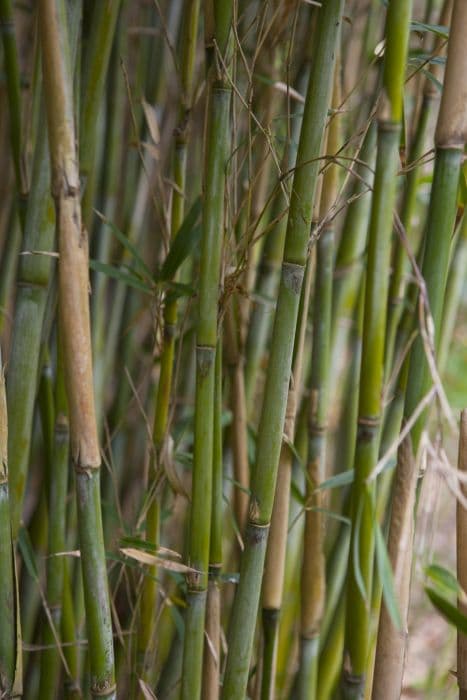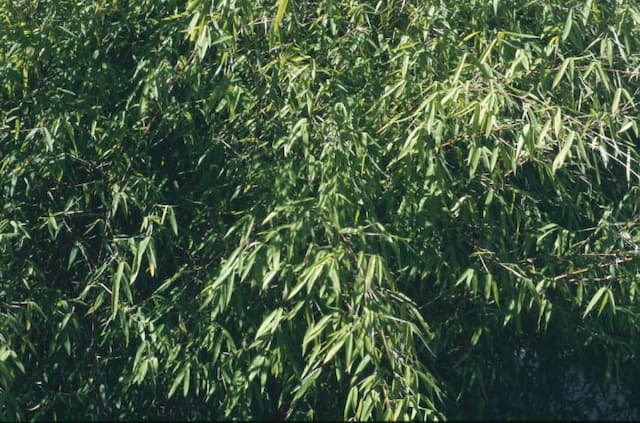Eulalia 'Silberspinne' Miscanthus sinensis 'Silberspinne'










ABOUT
'Silberspinne' is a lower growing grass , bearing open white-tinged red panicles,fading to silver from late summer to autumn.
About this plant
 Names
NamesFamily
Poaceae.
Synonyms
Chinese Silver Grass, Maiden Grass, Eulalia, Silver Banner Grass, Zebra Grass, Porcupine Grass.
Common names
Miscanthus sinensis 'Silberspinne'.
 Characteristics
CharacteristicsLife cycle
Perennials
Foliage type
Deciduous
Color of leaves
Green
Flower color
Silvery
Height
4-6 feet (1.2-1.8 meters)
Spread
2-3 feet (0.6-0.9 meters)
Plant type
Grass
Hardiness zones
5-9
Native area
Asia
Benefits
 General Benefits
General Benefits- Ornamental Appeal: Adds visual interest to gardens with its tall, slender form and silver-spun flower heads.
- Drought Tolerance: Once established, it can tolerate dry conditions, reducing the need for frequent watering.
- Winter Interest: Provides structure in the garden during the winter months as the foliage and seed heads remain attractive.
- Low Maintenance: Requires minimal care beyond initial planting and occasional cutting back.
- Erosion Control: Its root system helps stabilize soil and prevent erosion on slopes or banks.
- Privacy Screen: Can be used as a natural screen or hedge to provide privacy due to its height and dense growth.
- Habitat for Wildlife: Attracts birds and provides shelter for various species with its tall growth and seed production.
- Adaptability: Grows in a wide range of soil types, from well-drained to clay.
- Seasonal Color: Offers a change of colors through the seasons, from green to copper in autumn and tan in winter.
 Medical Properties
Medical PropertiesThis plant is not used for medical purposes.
 Air-purifying Qualities
Air-purifying QualitiesThis plant is not specifically known for air purifying qualities.
 Other Uses
Other Uses- Miscanthus sinensis 'Silberspinne', commonly known as Silver Spider Maiden Grass, can be used in the production of paper products owing to its fibrous material.
- The dense growth habit of Silver Spider Maiden Grass makes it suitable for use as a living screen or privacy barrier in landscapes.
- Its tall and stiff stalks can be harvested and used in the construction of lightweight garden structures like trellises and plant supports.
- Silver Spider Maiden Grass is sometimes utilized as a natural dye plant, offering a range of earthy tones for textiles.
- The dried plumes and foliage can be utilized in floral arrangements and as a component in crafting wreaths and other decorative items.
- The bio-mass produced by this grass has potential as a biofuel source, providing an alternative energy option.
- As a sturdy grass, Silver Spider Maiden Grass can be used for erosion control on slopes and embankments, protecting soil from being washed away.
- The plant can contribute to noise reduction strategies in landscaping, particularly alongside busy roads or in urban environments.
- It can be used in permaculture designs as a functional plant that aids in the balance of a self-sustaining ecosystem.
- While not a common use, the tall, distinctive seed heads can be used as a natural material in basket weaving and other fiber arts.
Interesting Facts
 Feng Shui
Feng ShuiThe plant Maiden Grass is not used in Feng Shui practice.
 Zodiac Sign Compitability
Zodiac Sign CompitabilityThe plant Maiden Grass is not used in astrology practice.
 Plant Symbolism
Plant Symbolism- Resilience: Miscanthus sinensis 'Silberspinne', also known as Chinese Silver Grass, is a hardy plant that can thrive in various conditions. Its ability to adapt symbolizes resilience and the capacity to withstand adversity.
- Growth: Chinese Silver Grass grows quickly and reaches tall heights, which can be seen as a symbol of personal growth, prosperity, and the pursuit of one's ambitions.
- Privacy: The dense growth habit of this plant often leads to its use as a natural screen, symbolizing the need for privacy or protection.
- Flexibility: Despite its height, the narrow leaves of Chinese Silver Grass sway gracefully with the wind. This characteristic represents flexibility and the ability to bend without breaking in the face of challenges.
- Timelessness: As a perennial, Chinese Silver Grass returns year after year, symbolizing longevity, timelessness, and enduring presence.
 Water
WaterThe Maiden Grass should be watered deeply once a week, providing about 1 to 1.5 inches of water each time. During hot, dry spells, the frequency may need to be increased to twice a week. Ensure that the soil around the plant is moist but not waterlogged. It's essential to water at the base of the plant to keep the foliage dry, which helps prevent disease. If planted in containers, they may require more frequent watering to prevent the soil from drying out too quickly, potentially every few days.
 Light
LightMaiden Grass thrives best in full sun, meaning it requires at least 6 hours of direct sunlight each day. An ideal spot would be an open area in the garden that is not shaded by trees or buildings during the day. Partial shade is tolerable, especially in hotter regions, but too much shade can result in less vigorous growth and fewer plumes.
 Temperature
TemperatureMaiden Grass is hardy and can tolerate a temperature range between 5°F to -20°F. However, the ideal growing temperatures are between 40°F and 90°F. It is robust in a range of climates, withstanding heat well and surviving cold winters.
 Pruning
PruningPrune Maiden Grass in late winter to early spring, before new shoots emerge. The reason to prune at this time is to remove the old foliage, which allows for new growth and maintains the plant's tidy appearance. Cut the grass down to about 4 to 6 inches above the ground. Pruning should be done annually.
 Cleaning
CleaningAs needed
 Soil
SoilMaiden Grass requires well-draining soil with a pH between 5.5 and 7.5. A mix of loamy soil with compost is ideal to provide nutrients and retain moisture while preventing waterlogging.
 Repotting
RepottingMaiden Grass typically does not require frequent repotting as it is commonly grown as an outdoor perennial. Divide clumps every few years to maintain vigor.
 Humidity & Misting
Humidity & MistingMaiden Grass is adaptable to a wide range of humidity levels and does not require specific humidity conditions as it thrives in outdoor environments.
 Suitable locations
Suitable locationsIndoor
Provide full sun and well-draining soil for indoor Maiden Grass.
Outdoor
Plant Maiden Grass in full sun, well-draining soil; water regularly.
Hardiness zone
4-9 USDA
 Life cycle
Life cycleMiscanthus sinensis 'Silberspinne', commonly known as Silver Spider Miscanthus, begins its life cycle with germination from seed, although it is more commonly propagated through division. After establishing a root system, it enters a rapid vegetative growth phase in spring, producing tall, slender stems and long, narrow leaves. Throughout the summer, it continues to grow, reaching heights of up to 6 feet. In late summer to early fall, it produces feathery flower plumes that can catch the sunlight, giving the plant its 'silver' quality. After flowering, the plant goes dormant in winter, shedding its leaves and remaining as dry stalks. In the following spring, the cycle can be rejuvenated by cutting back the old growth, allowing new shoots to emerge from the plant's base.
 Propogation
PropogationPropogation time
Late winter-early spring
Propogation: Miscanthus sinensis 'Silberspinne', more commonly known as Silver Spider Miscanthus, is typically propagated through division, which is best done in the late spring as the plant begins to grow. To propagate through division, you would start by digging up an established clump of the plant, ensuring you have a substantial root ball. Once the clump is out of the ground, you can use a sharp spade or knife to divide the root mass into smaller sections, each with several shoots and a healthy portion of roots. These sections can then be replanted at the same depth they were originally growing, spaced about 3 to 5 feet apart to give each new plant sufficient room to grow. Water the new divisions thoroughly after planting to help establish them. It is important to keep the soil consistently moist but not waterlogged as the new plants settle in.









